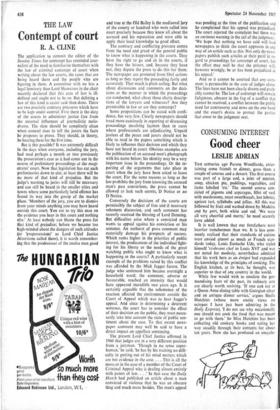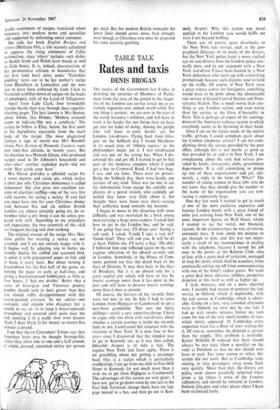Good cheer
CONSUMING INTEREST LESLIE ADRIAN
Two centuries ago Parson Woodforde, enter- taining some friends to dinner, gave- them a couple of courses and a dessert. The first course was part of a large cod, a joint of mutton, soup, chicken pie, puddings, vegetables, and items labelled `etc.' The second course con- sisted of pigeons and asparagus, fillet of veal with mushrooms, roast sweetbreads, hot lobster, apricot tart, syllabubs and jellies. All this was followed by fruit and washed down by Madeira and by port, both white and red. `We were all very cheerful and merry,' he need scarcely have added.
It is well known that our forefathers were heartier trenchermen than we. It is less com- monly realised that their standards of cuisine were envied almost as much as French stan- dards today. Louis Eustache Ude, who styled himself `ci-devant chef to Louis XVI' and was not noted for modesty, nevertheless admitted that his work here as an émigré had expanded his knowledge of the principles of cooking. The English kitchen, at its best, he thought, was superior to that of any country in the world.
While few would wish to emulate the gor- mandising feats of the past, its culinary arts are clearly worth reviving. `If one can eat at a Queen Anne dining table with Georgian silver and an antique dinner service,' argues Sheila Hutchins (whose more exotic views on octopus I have just been admiring in the Daily Express), `I do not see why occasionally one should not cook the food that was meant to go with them.' So Miss Hutchins has been collecting old cookery books and eating her way steadily through their contents for about ten years. Now she has produced an encyclo-
paedic assortment of recipes, translated where necessary into modern terms and quantities and supported by enlivening social comment.
She calls her book English Recipes and others (Methuen 63s), a title scarcely calculated to appease the rising sentiments of Celtic nationalism, since 'others' includes such dishes as Scotch broth and Welsh laver bread, as well as Irish boxty. It is, indeed, characteristic of her no-nonsense attitude to boundaries that the first (and best) entry under 'Yorkshire pudding' turns out to be her mother's recipe from Blackburn in Lancashire and the next two to have been collected by Lady Clark (a Victorian scribbler-down of recipes on the backs of envelopes), wife of the Laird of Tillypronte.
Apart from Lady Clark, four formidable females bustle their way through these appetite- whetting pages. The best known is Mrs Beeton, about whom, like Homer, 'Modern research seems to indicate/She was a syndicate.' The easiest to follow is Eliza Acton, the first cook to list ingredients separately from the main body of the recipe. The most plagiarised (always a sign of merit) was Mrs Rundell, whose New System of Domestic Cookery went into sixty-five editions in twenty years. But the doyenne was Hannah Glasse, who produced recipes used in Dr Johnson's household and who—alas! another exploded myth—did not write 'first catch your hare.'
Mrs Glasse provides a splendid recipe for a sweet mutton and raisin pie, which makes it clear just why Christmas mincemeat is called mincemeat. She also gives two excellent ver- sions of chestnut stuffing—one of the very few valid reasons for eating a turkey. If you feel you must have one for your Christmas dinner (and between five and six million British families are almost certainly going to), do re- member what a dry brute it can be unless pre- pared with skill. According to my prejudices and experience, the two essentials of this skill are frequent basting and slow cooking.
The original sources of the recipe Miss Hut- chins prints for roasting a turkey are not revealed, and I am not entirely happy with it. It begins well by adjuring you to butter ex- tremely thickly the stuffed and seasoned bird, to cover it with greaseproof paper or foil, and to baste it every hour. But about turning it breast-down for the first half of the game, re- moving the paper as early as half-time, and giving a fourteen-pound bubblyjock as little as four hours, I `hae ma doobts.' Better that a score of Georgian and Victorian poultry pundits should turn in their graves than that you should suffer disappointment with this coarse-grained creature. So my advice—not cocksure, and anyone who disagrees has a month to say so—is to keep it breast-upwards throughout and covered until quite near the end, cooking it in a really slow oven (nearer Mark 2 than Mark 3) for twenty to twenty-five minutes a pound.
I see that the us Consumers' Union says that American hosts may be thought Scrooge-like unless they allow one to one and a half pounds of whole, dressed, uncooked turkey per person
per meal. But for modern British stomachs the lower limit should prove more than enough, even though at Christmas you must be prepared for some atavistic guzzling.















































 Previous page
Previous page